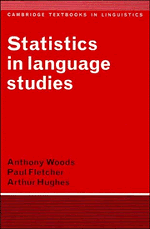Book contents
- Frontmatter
- Contents
- Preface
- 1 Why do linguists need statistics?
- 2 Tables and graphs
- 3 Summary measures
- 4 Statistical inference
- 5 Probability
- 6 Modelling statistical populations
- 7 Estimating from samples
- 8 Testing hypotheses about population values
- 9 Testing the fit of models to data
- 10 Measuring the degree of interdependence between two variables
- 11 Testing for differences between two populations
- 12 Analysis of variance – ANOVA
- 13 Linear regression
- 14 Searching for groups and clusters
- 15 Principal components analysis and factor analysis
- Appendix A Statistical tables
- Appendix B Statistical computation
- Appendix C Answers to some of the exercises
- References
- Index
6 - Modelling statistical populations
Published online by Cambridge University Press: 05 June 2012
- Frontmatter
- Contents
- Preface
- 1 Why do linguists need statistics?
- 2 Tables and graphs
- 3 Summary measures
- 4 Statistical inference
- 5 Probability
- 6 Modelling statistical populations
- 7 Estimating from samples
- 8 Testing hypotheses about population values
- 9 Testing the fit of models to data
- 10 Measuring the degree of interdependence between two variables
- 11 Testing for differences between two populations
- 12 Analysis of variance – ANOVA
- 13 Linear regression
- 14 Searching for groups and clusters
- 15 Principal components analysis and factor analysis
- Appendix A Statistical tables
- Appendix B Statistical computation
- Appendix C Answers to some of the exercises
- References
- Index
Summary
We pointed out in chapter 4 that the solution of many of our problems will depend on our ability to infer accurately from samples to populations. In chapter 5 we introduced the basic elements of probability and argued that it is by means of probability statements concerning random variables that we will be able to make inferences from samples to populations. In the present chapter we introduce the notion of a statistical model and describe one very common and important model.
We should say at the outset that the models with which we are concerned here are not of the kind most commonly met in linguistic studies. They are not, for instance, like the morphological models proposed by Hockett (1954); nor do they resemble the psycholinguists' models of speech production and perception. The models discussed in this chapter are statistical models for the description and analysis of random variability. No special mathematical knowledge or aptitude is required in order to understand them.
A simple statistical model
Statistical models are best introduced by means of an example. In chapter 1 we discussed in detail a study which looked at the voice onset time (VOT) for word-initial plosives in the speech of children in repeated samples over an eight-month period. For our present purpose we w7ill consider only the VOTs for one pair of stop targets, /t/ and /d/, for one child at 1;8. To make our exposition easier, we will also assume that the tokens were in the same environment (in this case preceding/uː/).
Information
- Type
- Chapter
- Information
- Statistics in Language Studies , pp. 77 - 94Publisher: Cambridge University PressPrint publication year: 1986
